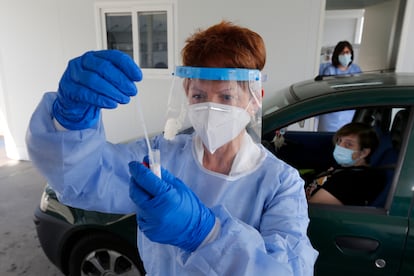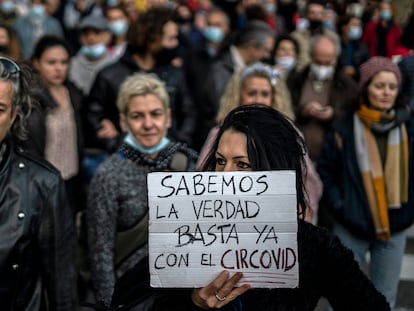Spain reports 38,273 new coronavirus cases and adds 484 victims since Friday
The incidence rate has fallen in nearly all regions and territories, while pressure on intensive care units is also beginning to ease

The coronavirus data sent by Spain’s regions to the central Health Ministry showed a clear improvement on Monday, according to the daily report that is published each weekday. Compared with the data released on Friday, all Spanish territories apart from Asturias and Cantabria have registered a fall in the 14-day cumulative number of coronavirus cases per 100,000 inhabitants, one of the key indicators being used to track the progress of the epidemic.
However, Fernando Simón, the director of the Health Ministry’s Coordination Center for Health Alerts (CCAES), and the public face of the ongoing crisis in Spain, voiced a note of caution, saying that the more positive numbers “are not definitive.” He warned against considering “the trend to be a victory,” given that the figure of 470.28 cases per 100,000 inhabitants contained in Monday’s report is still eight times the maximum considered by the European Union (60) as having the pandemic under control. That said, the figure has fallen now in five consecutive reports, down 11% from November 11, when the number was 529.43. With that weekly reduction, it would take another three months before the incidence is back where it was at the end of the government’s deescalation process, which concluded in June after a strict lockdown.
Health authorities say the fall in the number of coronavirus cases could be a sign that the country is entering a period of stabilization
A total of 38,273 new cases were included in Monday’s report, a figure that covers Friday, Saturday and Sunday given that no data is released over the weekend. That’s an average of 12,758 a day for the three-day period, bringing the total number of confirmed cases in Spain since the crisis began to 1,496,864. The real number of infections, however, is likely to be around 2.4 million, given that an infection survey carried out earlier in the year showed that around 5% of the population has had the coronavirus. A new such survey is underway, Simón pointed out on Monday, something that will provide a more exact picture of where this percentage is some eight months into the health crisis.
The fall in the number of cases, Simón explained, could be a sign that the country is entering a period of stabilization and that the curve is beginning to fall, given that the positivity rate – i.e. the number of coronavirus tests that come back positive – is also on the way down. On November 9, this data point was at 13.49%. On Monday, it was at 11.66%.
The number of victims is also falling. On Monday, 484 Covid-related deaths were added to the total – that’s compared to 512 that were reported last Monday. The fall is proportionally greatly inferior to that of cases. This is due to the fact that the people who have passed away generally picked up the infection three weeks ago, when the number of new cases was growing fast. All of Spain’s territories, apart from Asturias and the North African exclave city of Ceuta, have seen fewer deaths in the last seven days than they did in Friday’s report. The official death toll now stands at 41,253 victims, but studies from the Carlos III Health Institute and Spain’s National Statistics Institute suggest that the real figure is closer to 60,000.
The improving figures are not, for now, translating into relief for Spain’s hospitals. The percentage of beds that are being used to treat Covid patients is rising bit by bit, and now stands at 16.54% of the total. On Friday, the figure was 16.15%. In Asturias, the percentage exceeds 30%, which explains the regional government’s interest in implementing even tougher restrictions for the public, including a home confinement like the one that was in place in the spring. But Simón said on Monday that he believed the current measures in place were enough, given that there are perimetral lockdowns in force for the region and its biggest cities, non-essential businesses are closed, and a nighttime curfew from 10pm onward is in place.
Studies suggest the real coronavirus death toll in Spain may be closer to 60,000
Navarre announced on Monday that it would maintain the perimetral confinement of the region, as well as a six-person limit on social meetings until December 18. The hospitality sector is also closed in the northern territory, until at least December 2. Two weeks ago, the 14-day cumulative number of coronavirus cases per 100,000 inhabitants was 1,102.24. That figure has now come down to 591.40. That said, more than 40% of intensive care unit (ICU) beds are occupied by Covid patients.
Madrid is the only region where the incidence has been falling consistently for more than a month now. On October 19, the cumulative number of cases per 100,000 inhabitants was 439.33, whereas on Monday the figure was 310.52. As a result, the region has lifted the perimetral confinement of 10 basic healthcare areas.
Since the start of the pandemic, there have been 175,477 hospital admissions of Covid-19 patients. In terms of ICU beds, occupation has fallen slightly, according to the latest report, from 32.8% to 31.75%. The average length of treatment is also falling slightly, Simón explained on Monday. In total, 14,921 people have required ICU treatment in Spain since the pandemic began.
English version by Simon Hunter.
Tu suscripción se está usando en otro dispositivo
¿Quieres añadir otro usuario a tu suscripción?
Si continúas leyendo en este dispositivo, no se podrá leer en el otro.
FlechaTu suscripción se está usando en otro dispositivo y solo puedes acceder a EL PAÍS desde un dispositivo a la vez.
Si quieres compartir tu cuenta, cambia tu suscripción a la modalidad Premium, así podrás añadir otro usuario. Cada uno accederá con su propia cuenta de email, lo que os permitirá personalizar vuestra experiencia en EL PAÍS.
¿Tienes una suscripción de empresa? Accede aquí para contratar más cuentas.
En el caso de no saber quién está usando tu cuenta, te recomendamos cambiar tu contraseña aquí.
Si decides continuar compartiendo tu cuenta, este mensaje se mostrará en tu dispositivo y en el de la otra persona que está usando tu cuenta de forma indefinida, afectando a tu experiencia de lectura. Puedes consultar aquí los términos y condiciones de la suscripción digital.
More information
Últimas noticias
Most viewed
- Sinaloa Cartel war is taking its toll on Los Chapitos
- Oona Chaplin: ‘I told James Cameron that I was living in a treehouse and starting a permaculture project with a friend’
- Reinhard Genzel, Nobel laureate in physics: ‘One-minute videos will never give you the truth’
- Why the price of coffee has skyrocketed: from Brazilian plantations to specialty coffee houses
- Silver prices are going crazy: This is what’s fueling the rally










































